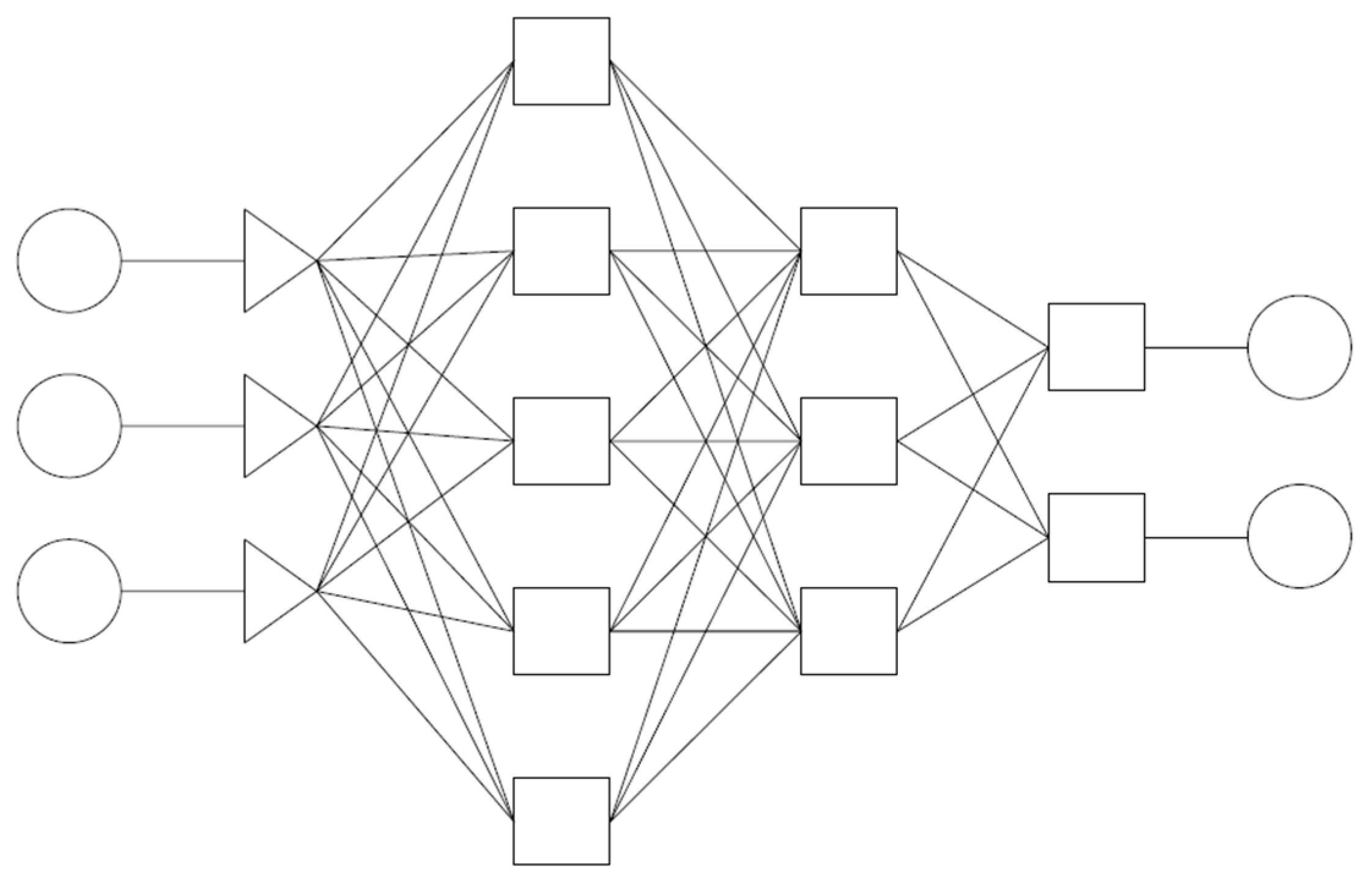The Role and Place of Traditional Chimney System Solutions in Environmental Progress and in Reducing Energy Consumption
Abstract
:1. Introduction
1.1. Types of Chimney Construction
1.2. Requirements for Flue Pipes
- Be completely resistant to the stated flue gas temperatures.
- Have an adequate thermal resistance coefficient, which guarantees the maintenance of the safe temperature of the external jacket at specified flue gas temperatures, as well as the maintenance of the required operating parameters at low ambient temperatures (minimisation of condensation).
2. Materials and Methods
3. Results
3.1. Starting Assumptions for Thermal Calculations Results
- Upper part of the room: Rsi = 0.25 m2K/W.
- Lower part of the room: Rsi = 0.35 m2K/W.
- With significant shielding of the wall surface by objects such as furniture: Rsi = 0.50 m2K/W.
- ti = + 20.0 °C (rooms)
- tr = + 4.0 °C
- tw = − 5.0 °C
- where:
- ti means the indoor air temperature,
- tr means the temperature inside the tube (ceramic insert),
- tw means the temperature inside the ventilated space in the counterflow mode.
3.2. Results of Analyses Carried out Using Artificial Neural Networks
- Teachers (70% of case numbers).
- Test (15% of case numbers).
- Validation (15% of the number of cases).
- Characteristics of the problem: regression; this description of relationships is used to build models showing the actual relationship between the input data (explanatory) and the output variable (explained). In this case, the events are performed in the following sequence: the values of explanatory variables, neural network, the value of the explained variable.
- Number of inputs: 5.
- Network type: multilayer perceptron (unidirectional multilayer networks. MLP networks).
- Learning algorithm: BFGS (variable metric method).
- Number of neurons in the hidden layer: 4–6.
- Error function: sum of squares.
- Output function: linear.
4. Discussion
Author Contributions
Funding
Institutional Review Board Statement
Informed Consent Statement
Data Availability Statement
Conflicts of Interest
Appendix A


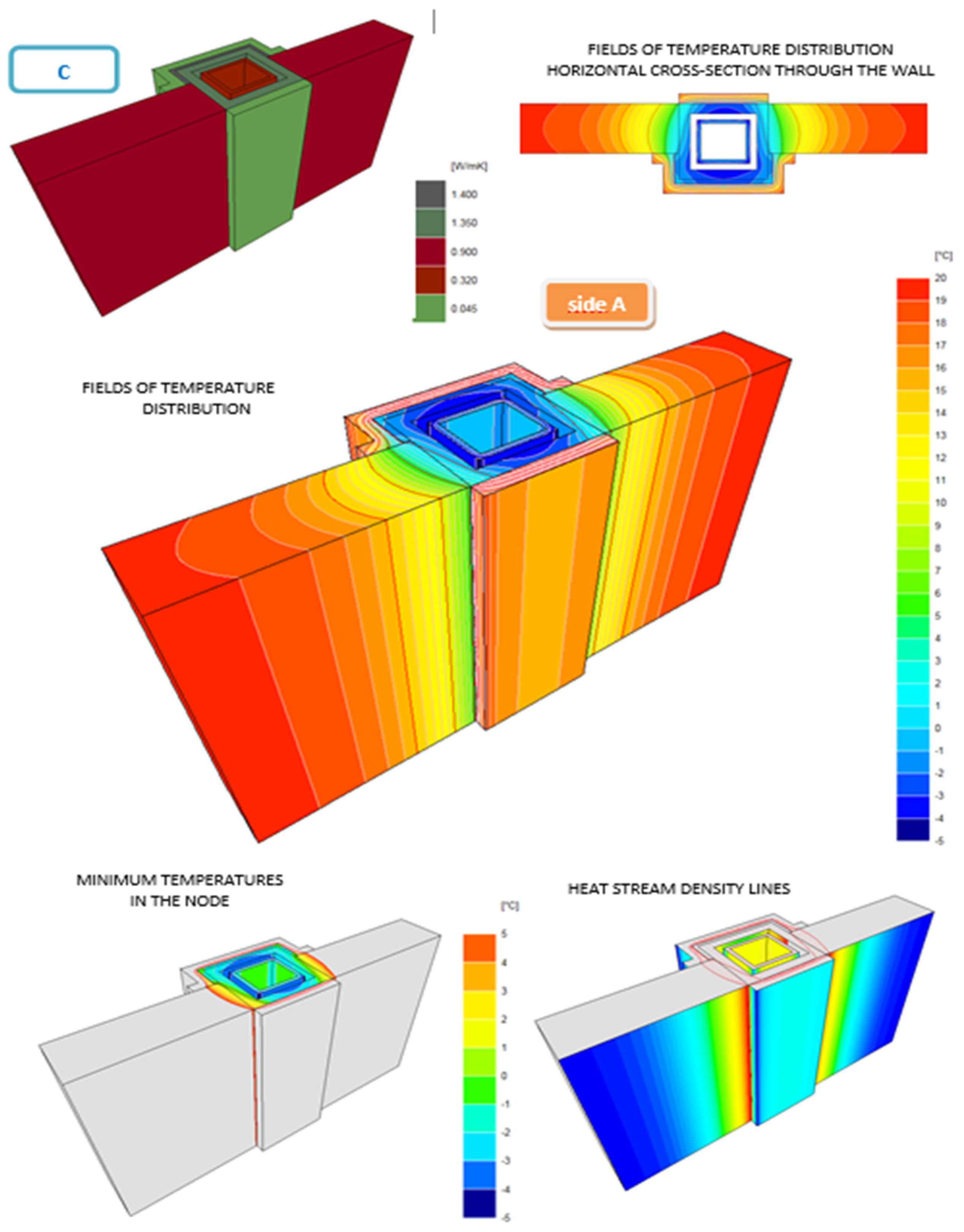
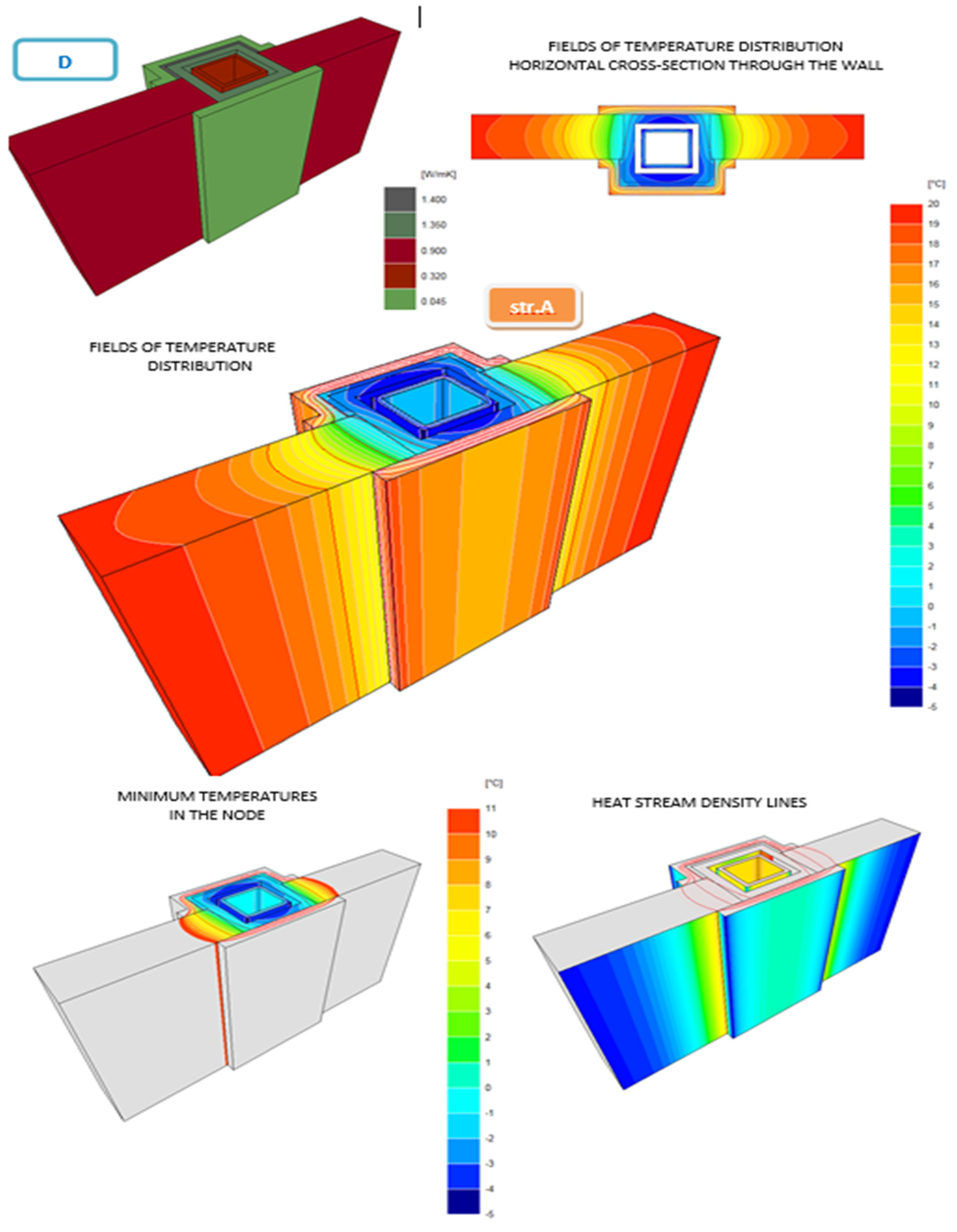

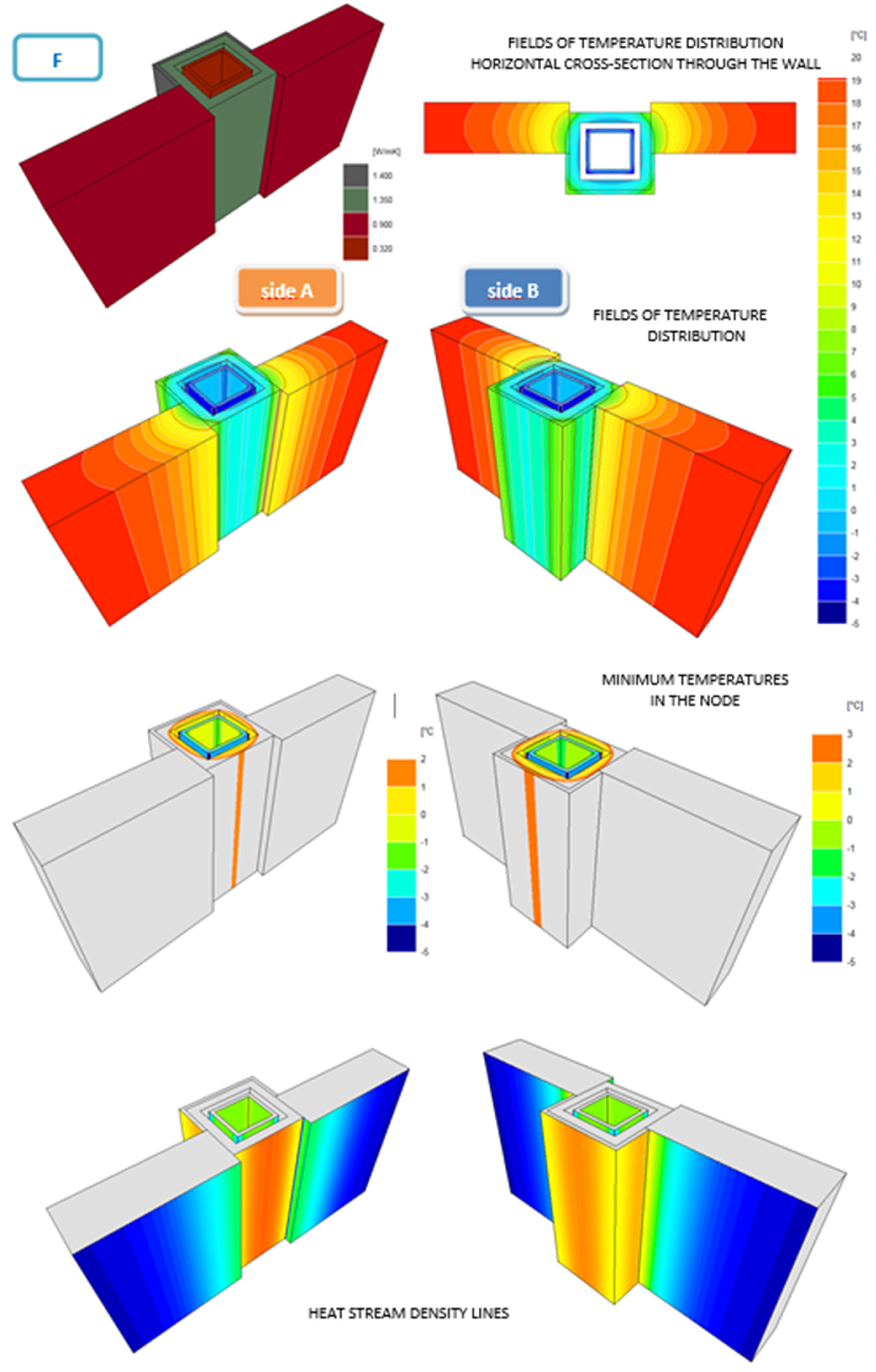


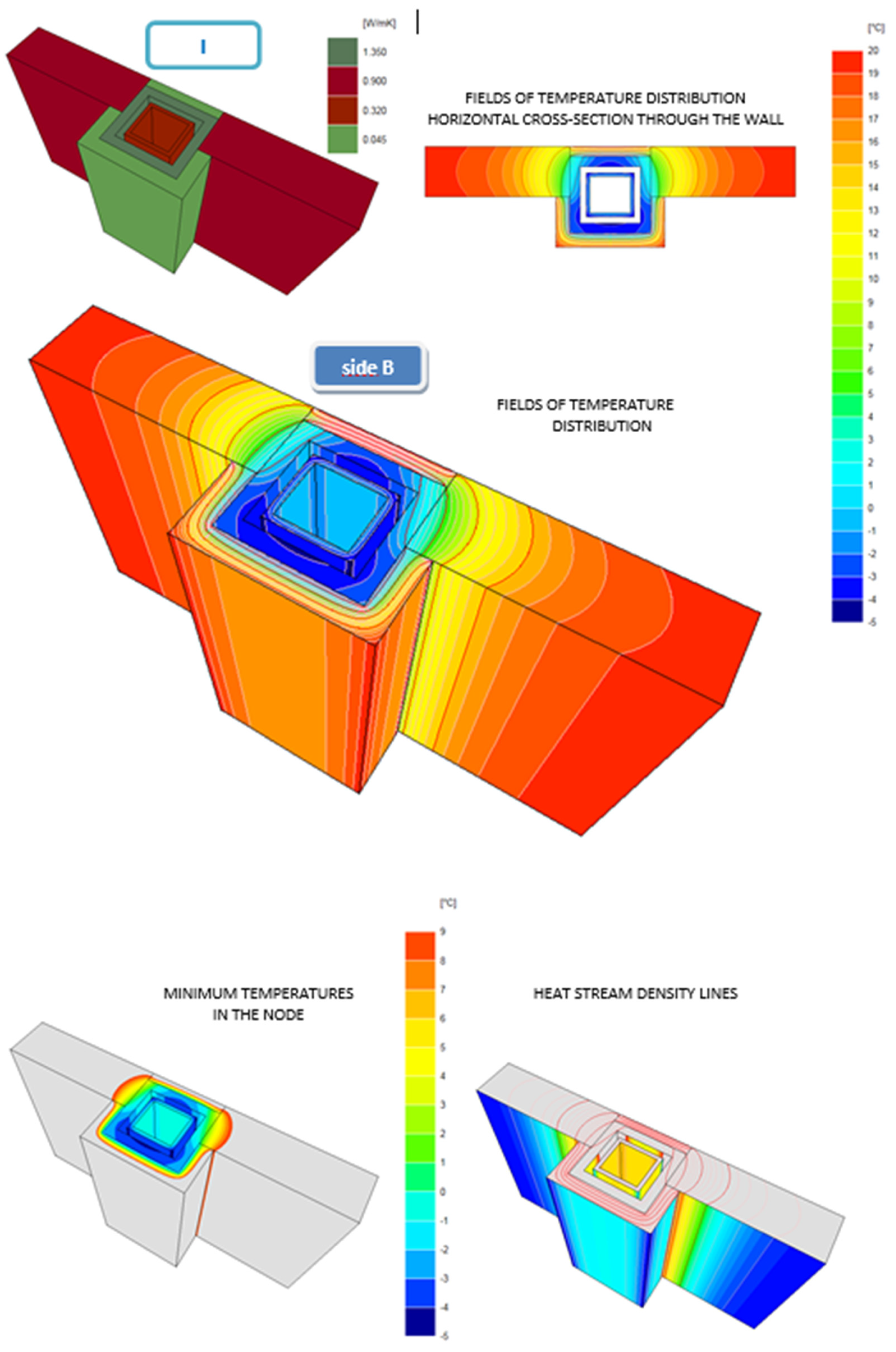

References
- Nowak, R. Efektywność energetyczna w aspekcie innowacyjnych systemów kominowych. GAZ WODA Tech. Sanit. 2020, 1, 20–23. [Google Scholar] [CrossRef]
- Salata, F.; Alippi, C.; Tarsitano, A.; Golasi, I.; Coppi, M. A First Approach to Natural Thermoventilation of Residential Buildings through Ventilation Chimneys Supplied by Solar Ponds. Sustainability 2015, 7, 9649–9663. [Google Scholar] [CrossRef] [Green Version]
- Motyl, P.; Wikło, M.; Bukalska, J.; Piechnik, B.; Kalbarczyk, R. A New Design for Wood Stoves Based on Numerical Analysis and Experimental Research. Energies 2020, 13, 1028. [Google Scholar] [CrossRef] [Green Version]
- Rezaei, A.; Samadzadegan, B.; Rasoulian, H.; Ranjbar, S.; Abolhassani, S.S.; Sanei, A.; Eicker, U. A New Modeling Approach for Low-Carbon District Energy System Planning. Energies 2021, 14, 1383. [Google Scholar] [CrossRef]
- Lipnicki, Z.; Gortych, M.; Staszczuk, A.; Kuczyński, T.; Grabas, P. Analytical and Experimental Investigation of the Solar Chimney System. Energies 2019, 12, 2060. [Google Scholar] [CrossRef] [Green Version]
- Hidaka, K.; Miyazawa, A.; Hu, H.; Mitsuji, K.; Nagai, Y.; Yoshimoto, N.; Suenaga, Y. Basic Study of Ventilation Using Semi-Transparent Organic Photovoltaic Sheets for Solar Chimney Systems. Technologies 2018, 6, 93. [Google Scholar] [CrossRef] [Green Version]
- Han, C.; Li, G.; Ding, Y.; Yan, F.; Bai, L. Chimney Detection Based on Faster R-CNN and Spatial Analysis Methods in High Resolution Remote Sensing Images. Sensors 2020, 20, 4353. [Google Scholar] [CrossRef] [PubMed]
- Daliga, K.; Kurałowicz, Z. Comparison of Different Measurement Techniques as Methodology for Surveying and Monitoring Stainless Steel Chimneys. Geosciences 2019, 9, 429. [Google Scholar] [CrossRef] [Green Version]
- Manfren, M.; Sibilla, M.; Tronchin, L. Energy Modelling and Analytics in the Built Environment—A Review of Their Role for Energy Transitions in the Construction Sector. Energies 2021, 14, 679. [Google Scholar] [CrossRef]
- Bonoli, A.; Zanni, S.; Serrano-Bernardo, F. Sustainability in Building and Construction within the Framework of Circular Cities and European New Green Deal. The Contribution of Concrete Recycling. Sustainability 2021, 13, 2139. [Google Scholar] [CrossRef]
- Rutkowska, G.; Klepak, O. Problemy strat ciepła w istniejących budynkach jednorodzinnych w kontekście błędów wykonawczych. Rocz. Ochr. Sr. 2013, 15, 2625–2639. [Google Scholar]
- Lee, K.H.; Strand, R.K. Enhancement of natural ventilation in buildings using a thermal chimney. Energy Build. 2009, 41, 615–621. [Google Scholar] [CrossRef]
- Adamu, Z.A.; Price, A.D. Natural Ventilation with Heat Recovery: A Biomimetic Concept. Buildings 2015, 5, 405–423. [Google Scholar] [CrossRef] [Green Version]
- Kim, J.; Kim, Y. Optimal Combination of External Wall Insulation Thickness and Surface Solar Reflectivity of Non-Residential Buildings in the Korean Peninsula. Sustainability 2021, 13, 3205. [Google Scholar] [CrossRef]
- Zhang, D.; Yang, Y.; Pan, M.; Gao, Z. Toward a Heat Recovery Chimney. Sustainability 2011, 3, 2115–2128. [Google Scholar] [CrossRef] [Green Version]
- PN-EN 1443:2019-05 Chimneys-General Requirements. Available online: https://sklep.pkn.pl/pn-en-1443-2019-05e.html (accessed on 30 July 2021).
- Rahman, M.M.; Chu, C.-M. Cold Inflow-Free Solar Chimney; Rahman, M.M., Chu, C.-M., Eds.; Springer: Singapore, 2021; ISBN 978-981-33-6830-9. [Google Scholar]
- Soto, A.; Martínez, P.J.; Tudela, J.A. Simulation and experimental study of residential building with north side wind tower assisted by solar chimneys. J. Build. Eng. 2021, 43, 102562. [Google Scholar] [CrossRef]
- Drozdzol, K. CFD Thermal Analysis of a Three-layer Chimney Used in Residential Buildings. J. Build. Eng. 2021, 44, 102665. [Google Scholar] [CrossRef]
- Kurpińska, M.; Karwacki, J.; Maurin, A.; Kin, M. Measurements of Thermal Conductivity of LWC Cement Composites Using Simplified Laboratory Scale Method. Materials 2021, 14, 1351. [Google Scholar] [CrossRef]
- Antczak-Jarząbska, R.; Niedostatkiewicz, M. Wpływ nasady kominowej na poprawę sprawności użytkowej wentylacji grawitacyjnej. Przegląd Bud. 2017, 88, 48–52. [Google Scholar]
- Pawłowski, K.; Nakielska., N. Selected design aspects of sections and joints in low energy buildings. Bud. Zoptymalizowanym Potencjale Energ. 2018, 7, 123–132. [Google Scholar] [CrossRef]
- Saifi, N.; Settou, N.; Dokkar, B.; Negrou, B.; Chennouf, N. Experimental Study And Simulation Of Airflow In Solar Chimneys. Energy Procedia 2012, 18, 1289–1298. [Google Scholar] [CrossRef] [Green Version]
- Leppänen, P.; Inha, T.; Pentti, M. An Experimental Study on the Effect of Design Flue Gas Temperature on the Fire Safety of Chimneys. Fire Technol. 2014, 51, 847–866. [Google Scholar] [CrossRef]
- Pallarés, F.J.; Ivorra, S.; Pallarés, L.; Adam, J.M. State of the art of industrial masonry chimneys: A review from construction to strengthening. Constr. Build. Mater. 2011, 25, 4351–4361. [Google Scholar] [CrossRef]
- Straatman, A.G.; Tarasuk, J.D.; Floryan, J.M. Heat Transfer Enhancement from a Vertical, Isothermal Channel Generated by the Chimney Effect. J. Heat Transf. 1993, 115, 395–402. [Google Scholar] [CrossRef]
- Jörg, O.; Scorer, R. An experimental study of cold inflow into chimneys. Atmospheric Environ. 1967, 1, 645–654. [Google Scholar] [CrossRef]
- McCloseky, F.G.; The Northern Ireland Housing Executive. Failures in traditionaly constructed domestic chimneys. In Proceedings of the 8th International Brick/Block Masonry Conference, Dublin, Ireland, 19–21 September 1988; pp. 1732–1738. [Google Scholar]
- Zhang, H.; Yang, D.; Tam, V.W.; Tao, Y.; Zhang, G.; Setunge, S.; Shi, L. A critical review of combined natural ventilation techniques in sustainable buildings. Renew. Sustain. Energy Rev. 2021, 141, 110795. [Google Scholar] [CrossRef]
- Corradi, M.; DI Schino, A.; Borri, A.; Rufini, R. A review of the use of stainless steel for masonry repair and reinforcement. Constr. Build. Mater. 2018, 181, 335–346. [Google Scholar] [CrossRef]
- Hartinger, S.M.; Commodore, A.A.; Hattendorf, J.; Lanata, C.F.; Gil, A.I.; Verastegui, H.; Aguilar-Villalobos, M.; Mäusezahl, D.; Naeher, L.P. Chimney stoves modestly improved Indoor Air Quality measurements compared with traditional open fire stoves: Results from a small-scale intervention study in rural Peru. Indoor Air 2013, 23, 342–352. [Google Scholar] [CrossRef] [Green Version]
- Maj, M.; Ubysz, A.; Hammadeh, H.; Askifi, F. Non-Destructive Testing of Technical Conditions of RC Industrial Tall Chimneys Subjected to High Temperature. Materials 2019, 12, 2027. [Google Scholar] [CrossRef] [Green Version]
- Al-Absi, Z.; Hafizal, M.; Ismail, M.; Ghazali, A. Towards Sustainable Development: Building’s Retrofitting with PCMs to Enhance the Indoor Thermal Comfort in Tropical Climate, Malaysia. Sustainability 2021, 13, 3614. [Google Scholar] [CrossRef]
- Leng, P.; Ling, G.H.T.; Ahmad, M.; Ossen, D.; Aminudin, E.; Chan, W.; Tawasil, D. Thermal Performance of Single-Story Air-Welled Terraced House in Malaysia: A Field Measurement Approach. Sustainability 2020, 13, 201. [Google Scholar] [CrossRef]
- Ustawa z 10 Września 2015 r. o Zmianie Ustawy–Prawo Ochrony Środowiska. Dziennik Ustaw RP z 12 Października 2015 r. poz. 1593. Available online: https://isap.sejm.gov.pl/isap.nsf/DocDetails.xsp?id=WDU20150001593 (accessed on 30 July 2021).
- Ustawa z Dnia 7 Lipca 1994 r. Prawo Budowlane (Dz. U. z 2018 r. poz. 1202. 1276. 1496 i 1669). Available online: http://isap.sejm.gov.pl/isap.nsf/DocDetails.xsp?id=WDU20180001202 (accessed on 30 July 2021).
- Rozporządzanie Ministra Infrastruktury z Dnia 12 Kwietnia 2002 r. w Sprawie Warunków Technicznych. Jakim Powinny Odpowiadać Budynki i Ich Usytuowanie (Tekst Jednolity Dz. U. z 2017 r. poz. 1523). Available online: https://isap.sejm.gov.pl/isap.nsf/DocDetails.xsp?id=WDU20020750690 (accessed on 30 July 2021).
- Rozporządzenie Ministra Transportu. Budownictwa i Gospodarki Morskiej z Dnia 5 Lipca 2013 r. Zmieniające rozporządzenie w sprawie warunków technicznych. Jakim powinny Odpowiadać Budynki i Ich Usytuowanie (Dz. U. Poz. 926). Available online: http://isap.sejm.gov.pl/isap.nsf/DocDetails.xsp?id=WDU20130000926 (accessed on 30 July 2021).
- Rozporządzenie Parlamentu Europejskiego i Rady (UE) nr 305/2011 z Dnia 9 Marca 2011 r. Ustanawiające Zharmonizowane Warunki Wprowadzania do Obrotu Wyrobów Budowlanych i Uchylające Dyrektywę Rady 89/106/EWG. Available online: https://eur-lex.europa.eu/legal-content/PL/TXT/PDF/?uri=CELEX:02011R0305-20140616&qid=1576663491684&from=EN (accessed on 30 July 2021).
- Dyrektywa Parlamentu Europejskiego i Rady 2010/30/UE z Dnia 19 Maja 2010 r. w Sprawie Wskazania Poprzez Etykietowanie Oraz Standardowe Informacje o Produkcie. Zużycia Energii Oraz Innych Zasobów Przez Produkty Związane z Energią. Available online: https://eur-lex.europa.eu/legal-content/PL/TXT/HTML/?uri=OJ:L:2010:153:FULL&from=NL (accessed on 30 July 2021).
- Dyrektywa 5 Parlamentu Europejskiego i Rady 2005/32/WE z Dnia 6 Lipca 2005. Available online: https://eur-lex.europa.eu/legal-content/PL/TXT/PDF/?uri=CELEX:32005L0032&from=en (accessed on 30 July 2021).
- Ustawa z Dnia 29 Sierpnia 2014 r. o Charakterystyce Energetycznej Budynków (Dz. U. poz. 1200 oraz z 2015 r. poz. 151). Available online: http://isap.sejm.gov.pl/isap.nsf/DocDetails.xsp?id=wdu20140001200 (accessed on 30 July 2021).
- Dyrektywa Parlamentu Europejskiego i Rady 2009/125/WE z dnia 21 Października 2009 r. Ustanawiająca Ogólne Zasady Ustalania Wymogów Dotyczących Ekoprojektu dla Produktów Związanych z Energią. Available online: https://eur-lex.europa.eu/legal-content/PL/TXT/PDF/?uri=CELEX:32009L0125&from=ES (accessed on 30 July 2021).
- Directive 2005/32/EC of the European Parliament and of the Council of 6 July 2005 Establishing a Framework for the Setting of Ecodesign Requirements for Energy-Using Products and Amending Council Directive 92/42/EEC and Directives 96/57/EC and 2000/55/EC of the European Parliament and of the Council. Available online: https://eur-lex.europa.eu/LexUriServ/LexUriServ.do?uri=OJ:L:2005:191:0029:0058:EN:PDF (accessed on 30 July 2021).
- Green Paper—A European Strategy for Sustainable, Competitive and Secure Energy; Official Journal of the European Union: Brussels, Belgium, 2006.
- Bajno, D. Ventilation as a particular safety element in housing development. In Monografia Rudolf Kania Opole; Polish Engineering Association (NOT): Vienna, Austria, 2011; pp. 173–180. [Google Scholar]
- PN-EN 1859+A1:2013-09 Kominy-Metody Badań. Available online: https://sklep.pkn.pl/pn-en-1859-a1-2013-09p.html (accessed on 30 July 2021).
- Qiao, M.; Xu, F.; Saha, S.C. Scaling analysis and numerical simulation of natural convection from a duct. Numer. Heat Transfer. Part A Appl. 2017, 72, 355–371. [Google Scholar] [CrossRef]
- Fedorczak-Cisak, M. Efektywność energetyczna oraz niska emisja w krajowych i regionalnych uwarunkowaniach prawnych. Mater. Bud. 2016, 1, 22–24. [Google Scholar] [CrossRef]
- Ujma, A.; Kysiak., A. Diagnostyka elementów konstrukcji budynków z wykorzystaniem kamery termowizyjnej. Bud. Zoptymalizowanym Potencjale Energ. 2015, 1, 182–190. [Google Scholar]
- Knyziak, P. Sztuczne sieci neuronowe w oszacowaniu zużycia technicznego bydynków mieszkalnych. In Theoretical Foundation of Civil Engineering; Oficyna Wydawnicza Politechniki Warszawskiej: Warszawa, Poland, 2008; Volume 16. [Google Scholar]
- Osowski, S. Sztuczne sieci neuronowe-Podstawowe struktury sieciowe i algorytmy uczaące. Prz. Elektrotechniczny 2009, 85, 1–8. [Google Scholar]
- Żurada, J.; Barski, M.; Jędruch, W. Sztuczne sieci neuronowe. Ann 2004, 1, 16–19. [Google Scholar]
- Chithra, S.; Kumar, S.S.; Chinnaraju, K.; Ashmita, F.A. A comparative study on the compressive strength prediction models for High Performance Concrete containing nano silica and copper slag using regression analysis and Artificial Neural Networks. Constr. Build. Mater. 2016, 114, 528–535. [Google Scholar] [CrossRef]
- Jasienko, J.; Bednarz, Ł.; Nowak, T. The effectiveness of strengthening historic brick vaults by contemporary methods. In Proceedings of the Protection of Historical Buildings, PROHITECH 09, Rome, Italy, 21–24 June 2009; pp. 1299–1304. [Google Scholar]
- Bajno, D.; Bednarz, L.; Matkowski, Z.; Raszczuk, K. Monitoring of Thermal and Moisture Processes in Various Types of External Historical Walls. Materials 2020, 13, 505. [Google Scholar] [CrossRef] [Green Version]
- Bajno, D. Defekty konstrukcyjno–budowlane w procesie realizacji oraz na etapie eksploatacji tradycyjnych kominów w budynkach mieszkalnych. In Szkody Kominowe; Rudolf Kania: Opole, Poland, 2015; pp. 103–120. [Google Scholar]
- ISO 12011-Technical Product Documentation-Technical Drawings; Lines-Part 1: Basic Conventions. Available online: https://www.iso.org/obp/ui/#iso:std:iso:128:-1:ed-1:en (accessed on 30 July 2021).
- PN-EN ISO 6946: 2008 Komponenty Budowlane i Elementy Budynku. Opór Cieplny i Współczynnik Przenikania Ciepła. Metoda Obliczania. Available online: http://sklep.pkn.pl/pn-en-iso-6946-2008d.html (accessed on 30 July 2021).

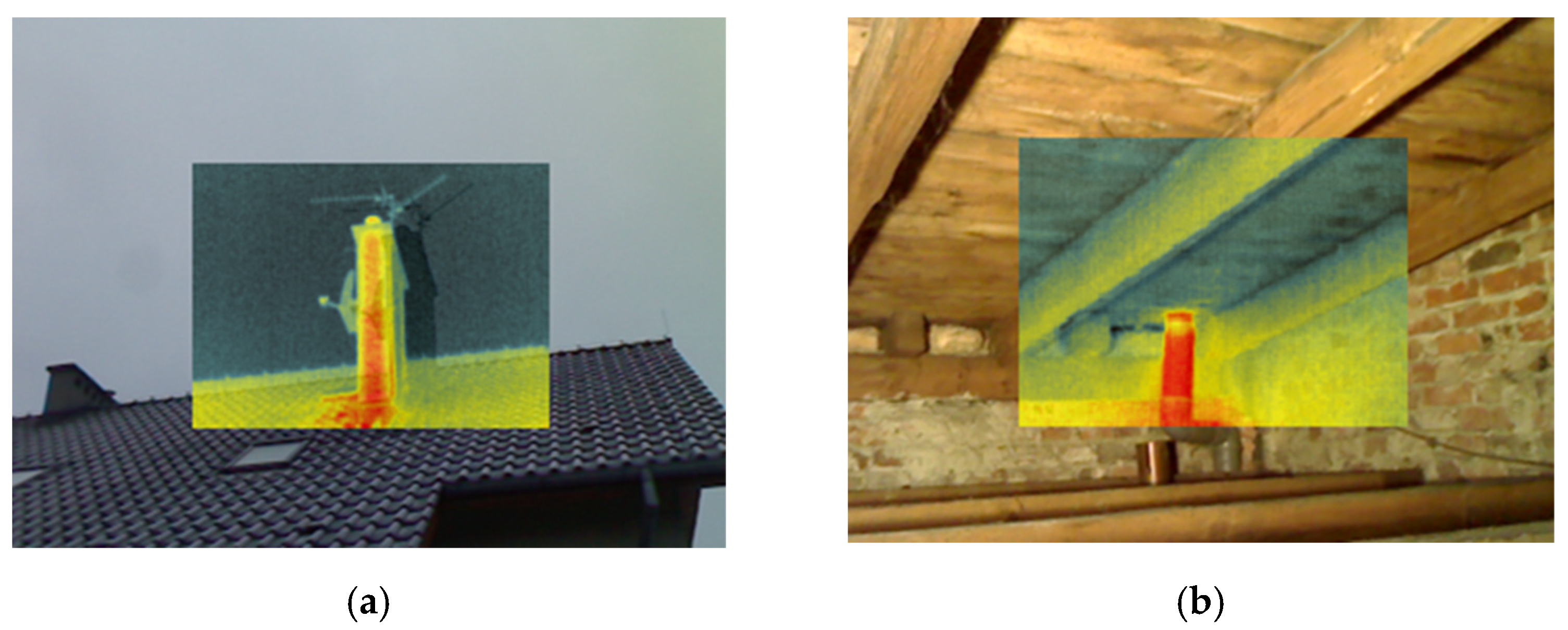




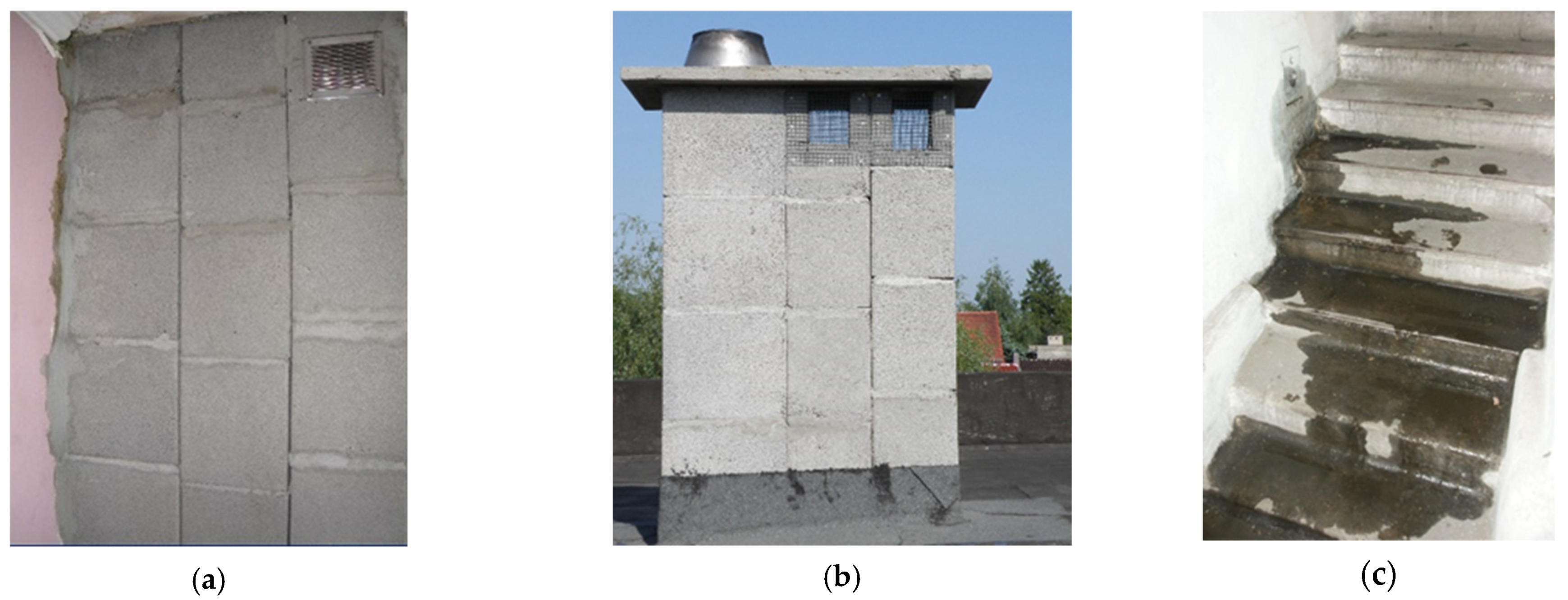
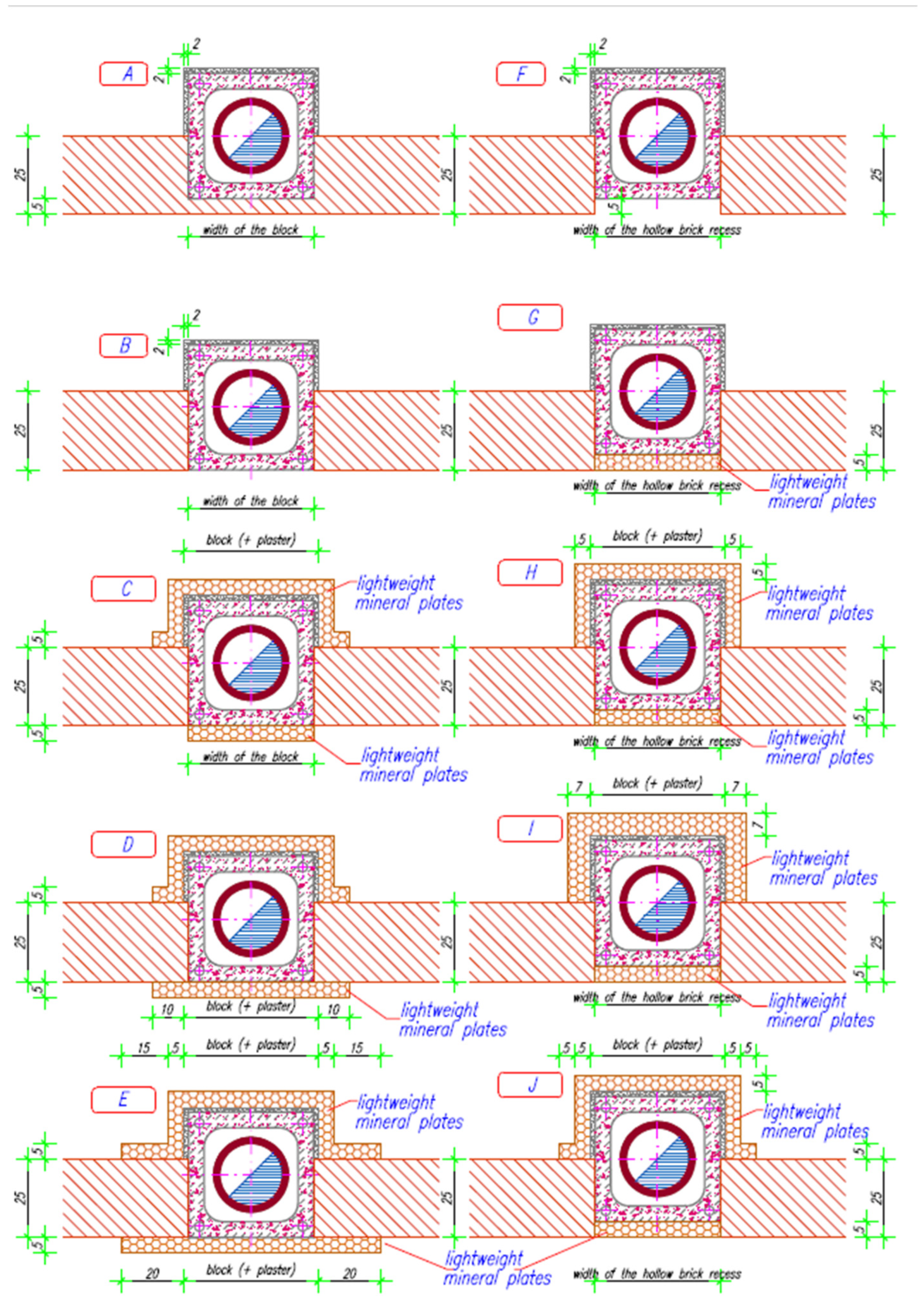
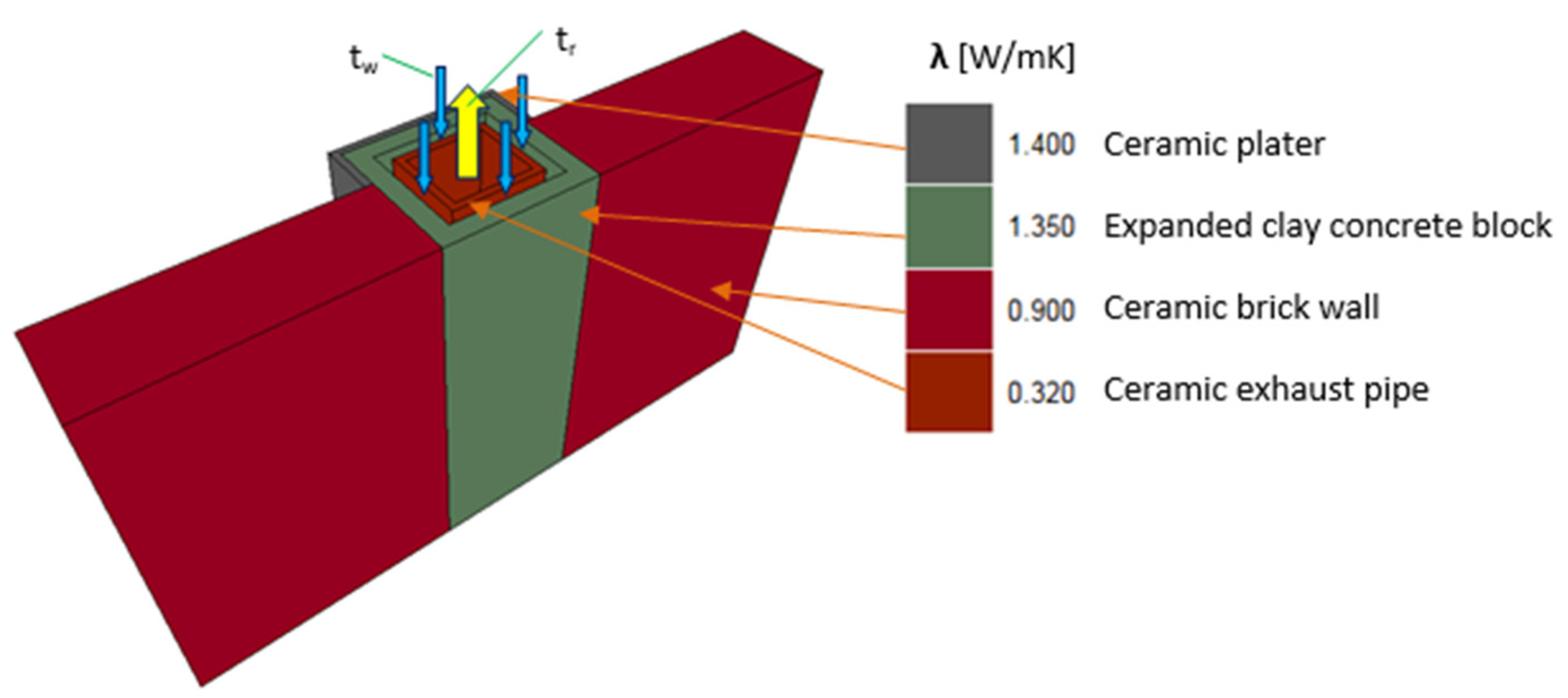
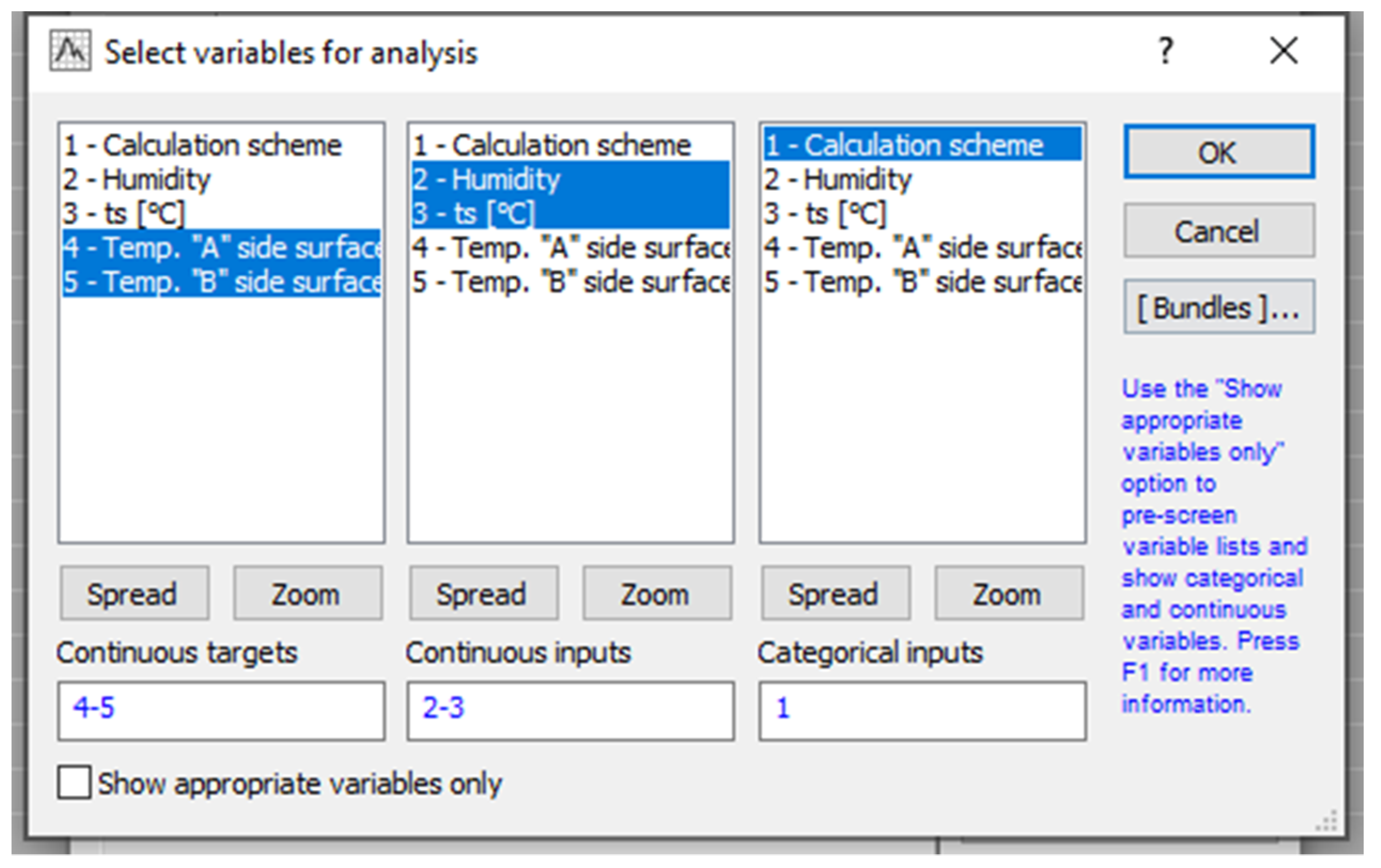

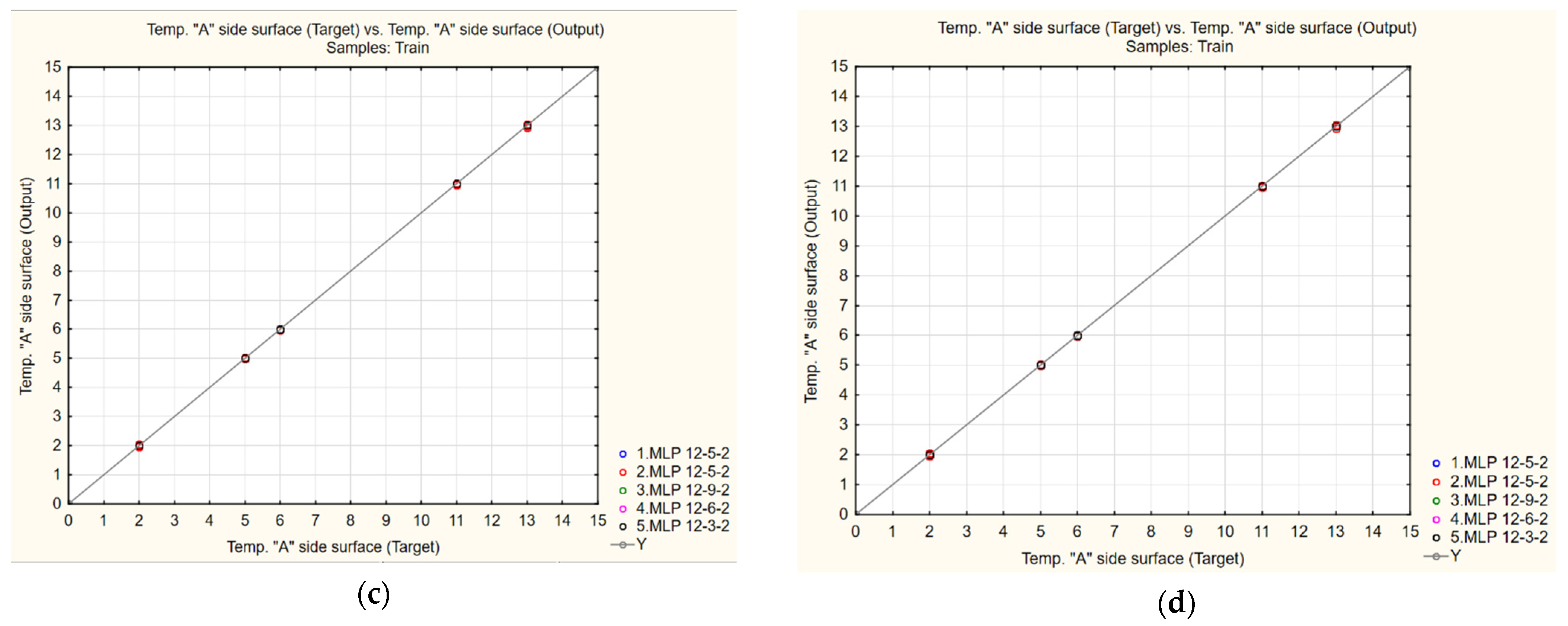

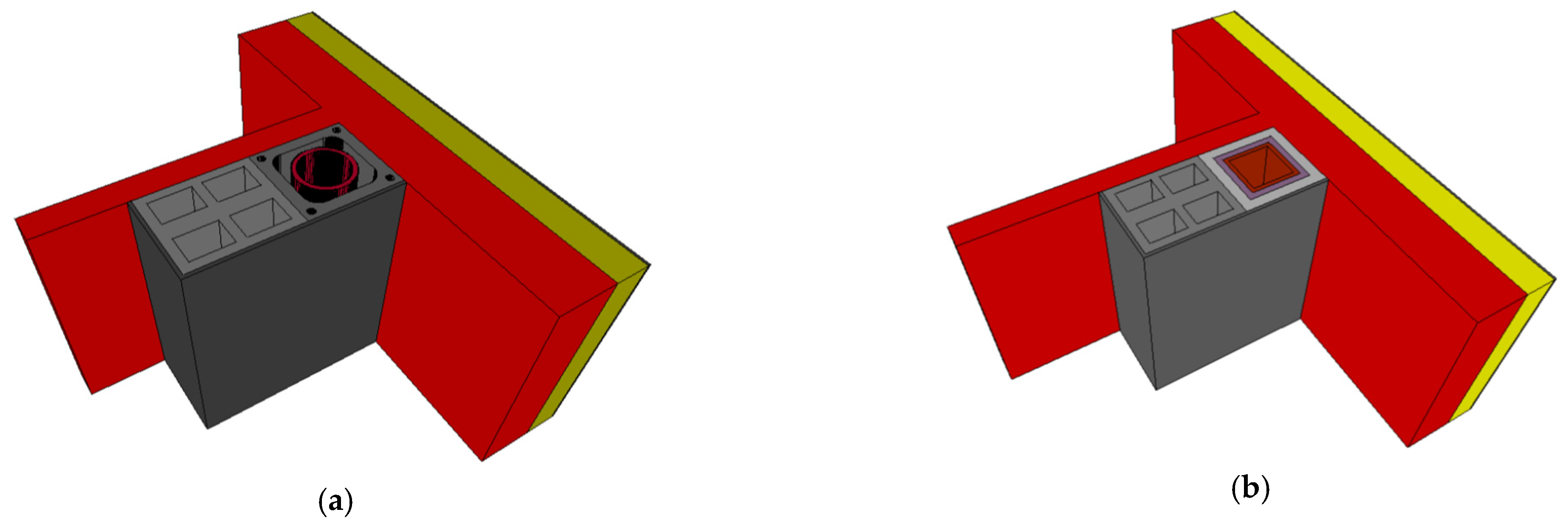
| Design Temperatures | Purpose or Use of Premises | Examples of Rooms |
|---|---|---|
| +20 °C |
| living rooms, anterooms, individual kitchen with gas or electric fires, offices, meeting rooms |
| +24 °C |
| bathrooms, changing rooms, washrooms, showers, swimming pool hall, doctor’s office, undressing, baby and nursery rooms, operating theatres |
| Calculation Scheme | ts (°C) | Surface Temperature Side “A” t (°C) | Surface Temperature Side “B” t (°C) | ||||||
|---|---|---|---|---|---|---|---|---|---|
| ti = +20 °C φ = 45% | ti = +20 °C φ = 55% | ti = +20 °C φ = 75% | ti = +20 °C φ = 45% | ti = +20 °C φ = 55% | ti = +20 °C φ = 75% | ||||
| A | 7.7 | 10.7 | 15.4 | +6.0 | +6.0 | +6.0 | +3.0 | +3.0 | +3.0 |
| B | 7.7 | 10.7 | 15.4 | +2.0 | +2.0 | +2.0 | +3.0 | +3.0 | +3.0 |
| C | 7.7 | 10.7 | 15.4 | +5.0 | +5.0 | +5.0 | +11.0 | +11.0 | +11.0 |
| D | 7.7 | 10.7 | 15.4 | +11.0 | +11.0 | +11.0 | +11.0 | +11.0 | +11.0 |
| E | 7.7 | 10.7 | 15.4 | +13.0 | +13.0 | +13.0 | +13.0 | +13.0 | +13.0 |
| F | 7.7 | 10.7 | 15.4 | +2.0 | +2.0 | +2.0 | +3.0 | +3.0 | +3.0 |
| G | 7.7 | 10.7 | 15.4 | +11.0 | +11.0 | +11.0 | +3.0 | +3.0 | +3.0 |
| H | 7.7 | 10.7 | 15.4 | +11.0 | +11.0 | +11.0 | +9.0 | +9.0 | +9.0 |
| I | 7.7 | 10.7 | 15.4 | +11.0 | +11.0 | +11.0 | +9.0 | +9.0 | +9.0 |
| J | 7.7 | 10.7 | 15.4 | +11.0 | +11.0 | +11.0 | +11.0 | +11.0 | +11.0 |
| Humidity | Calculation Scheme | ts (°C) | Temp. “A” Side Surface | Temp. “B” Side Surface |
|---|---|---|---|---|
| 45 | A | 7.7 | 6 | 3 |
| 45 | B | 7.7 | 2 | 3 |
| 45 | C | 7.7 | 5 | 11 |
| 45 | D | 7.7 | 11 | 11 |
| 45 | E | 7.7 | 13 | 13 |
| 45 | F | 7.7 | 2 | 3 |
| 45 | G | 7.7 | 11 | 3 |
| 45 | H | 7.7 | 11 | 9 |
| 45 | I | 7.7 | 11 | 9 |
| 45 | J | 7.7 | 11 | 11 |
| No. | Temp. “B” Side Surface | Prediction Spreadsheet for Temp. “B” Side Surface (Spreadsheet1)1. MLP 12-5-2 |
|---|---|---|
| 1 | 3.0 | 3.0 |
| 2 | 3.0 | 3.0 |
| 3 | 11.0 | 11.0 |
| 4 | 13.0 | 12.9 |
| 5 | 3.0 | 3.0 |
| … | ||
| 146 | 11.0 | 10.9 |
| 147 | 13.0 | 12.9 |
| 148 | 3.0 | 3.0 |
| 149 | 3.0 | 3.0 |
| 150 | 9.0 | 9.0 |
| Networks | Calculation Scheme | ts | Humidity |
|---|---|---|---|
| MLP 12-5-2 | 2.91 | 24.54 | 24.04 |
| MLP 12-5-2 | 5.37 | 8.13 | 7.26 |
| MLP 12-9-2 | 6.51 | 1.00 | 1.00 |
| MLP 12-6-2 | 1.06 | 1.01 | 1.02 |
| MLP 12-3-2 | 2.77 | 30.56 | 31.24 |
Publisher’s Note: MDPI stays neutral with regard to jurisdictional claims in published maps and institutional affiliations. |
© 2021 by the authors. Licensee MDPI, Basel, Switzerland. This article is an open access article distributed under the terms and conditions of the Creative Commons Attribution (CC BY) license (https://creativecommons.org/licenses/by/4.0/).
Share and Cite
Bajno, D.; Bednarz, Ł.; Grzybowska, A. The Role and Place of Traditional Chimney System Solutions in Environmental Progress and in Reducing Energy Consumption. Energies 2021, 14, 4720. https://doi.org/10.3390/en14164720
Bajno D, Bednarz Ł, Grzybowska A. The Role and Place of Traditional Chimney System Solutions in Environmental Progress and in Reducing Energy Consumption. Energies. 2021; 14(16):4720. https://doi.org/10.3390/en14164720
Chicago/Turabian StyleBajno, Dariusz, Łukasz Bednarz, and Agnieszka Grzybowska. 2021. "The Role and Place of Traditional Chimney System Solutions in Environmental Progress and in Reducing Energy Consumption" Energies 14, no. 16: 4720. https://doi.org/10.3390/en14164720





